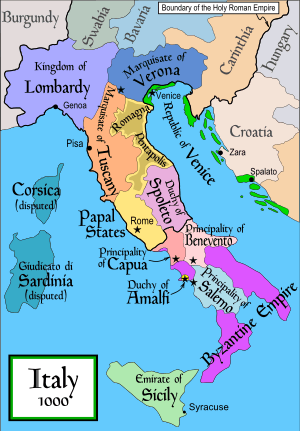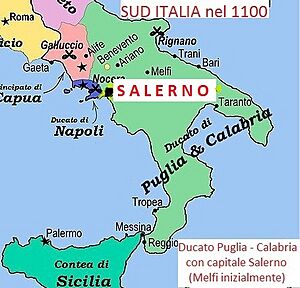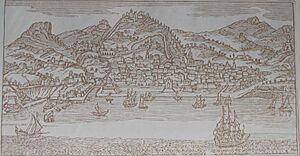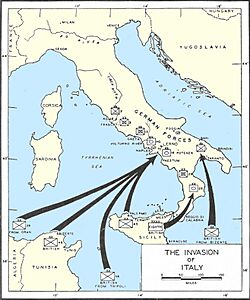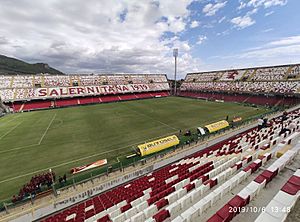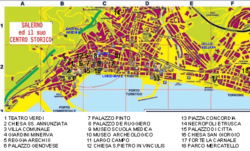Salerno facts for kids
Quick facts for kids
Salerno
Salierno (Neapolitan)
|
|||
|---|---|---|---|
| Comune di Salerno | |||
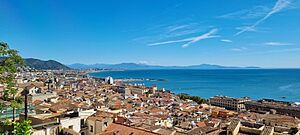
Panorama of Salerno
|
|||
|
|||
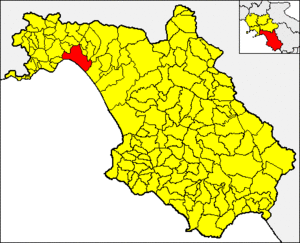
Salerno within the Province of Salerno and Campania
|
|||
| Country | Italy | ||
| Region | Campania | ||
| Province | Salerno (SA) | ||
| Founded | 197 BC | ||
| Area | |||
| • Total | 58.96 km2 (22.76 sq mi) | ||
| Elevation | 4 m (13 ft) | ||
| Population | |||
| • Total | 133,199 | ||
| • Density | 2,259.14/km2 (5,851.2/sq mi) | ||
| Demonym(s) | Salernitano | ||
| Time zone | UTC+1 (CET) | ||
| • Summer (DST) | UTC+2 (CEST) | ||
| Postal code |
84121–84135
|
||
| Dialing code | 089 | ||
| Patron saint | Saint Matthew | ||
Salerno is an old city and a comune (which means a municipality or town) in southwestern Italy. It is the capital of the Salerno province. It is the second-largest city in the Campania region, after Naples. Salerno is located on the Gulf of Salerno by the Tyrrhenian Sea.
In 1943, during World War II, the King of Italy, Victor Emmanuel III, moved to Salerno. He made it the temporary capital of the Italian government for six months. Also, some Allied forces landed near Salerno during their invasion of Italy.
Salerno has a very long and interesting history, going back to ancient times. In the Middle Ages, it was a powerful independent kingdom called the Principality of Salerno. During this time, the Schola Medica Salernitana, the first medical school in the world, was founded here. Later, in the 16th century, the city became a major center for learning and arts.
Today, Salerno is divided into three main parts: the old medieval area, the 19th-century part, and the newer areas built after World War II. The city's patron saint is Saint Matthew, whose relics are kept in the crypt of Salerno Cathedral.
Contents
History of Salerno
Salerno has been a home to people since prehistoric times. Very old human remains have been found here.
Ancient Times
The area was first settled by people who spoke the Oscan language. Later, the Etruscans arrived in the 6th century BC. They built a city called Irnthi near the Irno river. This city was important for trade with Greek colonies like Paestum and Velia. Around the 5th century BC, the Samnites took over Irnthi.
When the Romans expanded into Campania, Irnthi became less important. The Romans founded a new colony called Salernum in 197 BC. This new city grew from a military camp into a trading center. It was connected to Rome by an important road called the Via Popilia.
Archaeological finds show that Salernum was a busy and thriving city. In the late 3rd century AD, under Emperor Diocletian, Salernum became an important administrative center. After the Gothic Wars, Salerno was briefly controlled by the Byzantines. Then, in 646, the Lombards took control, and it became part of the Duchy of Benevento.
Middle Ages to Early Modern Age
Under the Lombard rulers, Salerno had a very successful period. In 774, Arechis II of Benevento moved the capital of the Duchy of Benevento to Salerno. He wanted to protect it from Charlemagne's attacks and control this important coastal area.
With Arechis II, Salerno became a center for learning, especially with its famous Medical School. The prince also ordered the city to be made stronger. A castle was built on Bonadies mountain with walls and towers. In 839, Salerno became independent from Benevento. It became the capital of a rich principality that included much of Southern Italy.
Around the year 1000, Prince Guaimar IV expanded his rule. He took over Amalfi, Sorrento, Gaeta, and the entire region of Apulia and Calabria. He even dreamed of uniting all of Southern Italy under Salerno. Coins from Salerno, marked Opulenta Salernum (Rich Salerno), were used all over the Mediterranean Sea.
However, the principality faced constant attacks from Saracens and internal conflicts. In 1056, Guaimar fell due to a plot. His son Gisulf II took over, but the principality began to decline. In 1077, the Normans, led by Robert Guiscard, besieged Salerno and defeated Gisulf.
During this time, new buildings like the Castel Terracena palace and the cathedral were constructed. The Schola Medica Salernitana reached its peak, becoming the oldest medical institution in Europe. It even welcomed women as students, like Trota of Salerno. By the late 11th century, Salerno had about 50,000 people. In 1100, Salerno became the capital of Norman Southern Italy.
Salerno was the most important Norman city for about 50 years. But after the Normans conquered Sicily, Palermo became more important. In 1191, when Emperor Henry VI invaded, Salerno surrendered quickly. However, in 1194, Salerno was the only city that resisted. It was then attacked and looted, which greatly reduced its importance.
Henry had a reason for this. Some Salerno citizens had betrayed him earlier by capturing his wife, Constance. Henry's son, Frederick II, later made laws that favored Naples over Salerno. He even founded the University of Naples there.
From the 14th century, the House of Sanseverino family controlled most of Salerno province. They were powerful lords who brought artists and thinkers to their palace. In the 15th century, the city was caught in battles between the French and Spanish royal families.
In the early 16th century, the last Sanseverino prince, Ferdinando Sanseverino, argued with the Spanish king's representative. This led to the family's downfall and a long period of decline for Salerno. The city slowly began to recover in the 18th century. Many beautiful houses and churches were built. In 1799, Salerno became part of the Parthenopean Republic.
During the time of Napoleon, the Schola Medica Salernitana was closed in 1811. Many religious groups were also shut down, and their properties were taken. The city grew beyond its old walls, and sea connections became more important for trade.
Modern and Contemporary Times
Salerno was a key center for the Carbonari, a secret society that supported the unification of Italy in the 19th century. Most people in Salerno supported the idea of Risorgimento (Italian unification) against the Bourbon rulers. In 1861, many joined Garibaldi in his fight.
After Italy was unified, Salerno continued to grow. New buildings were constructed, and suburban areas expanded. The city's population grew from 20,000 in 1861 to 80,000 in the early 20th century.
In the 19th century, foreign industries came to Salerno. The first textile mill was built in 1830. By 1877, Salerno had 21 textile mills employing about ten thousand workers. Because of this, Salerno was sometimes called the "Manchester of the two Sicilies."
In September 1943, during World War II, Salerno was the site of Operation Avalanche. This was the Allied invasion of Italy, and the city suffered a lot of damage. From February to July 1944, Salerno was the temporary capital of the Kingdom of Italy. King Victor Emmanuel III lived in a mansion nearby.
After the war, Salerno's population quickly doubled. It went from 80,000 in 1946 to almost 160,000 in 1976.
Geography of Salerno
Salerno is located at the northwestern end of the plain of the Sele River. It is also at the very beginning of the famous Amalfi coast. The small Irno river flows through the center of Salerno. The highest point near the city is "Monte Stella," which is 953 meters (3,127 feet) high.
Climate in Salerno
Salerno has a Mediterranean climate. This means it has hot and fairly dry summers. Temperatures can reach 31°C (88°F) in July and August. Winters are rainy, with highs around 13°C (55°F) in January. The city usually gets about 1,000 mm (39 inches) of rain each year. Strong winds blow from the mountains towards the Gulf of Salerno, making the city quite windy, especially in winter. However, this also makes Salerno one of the sunniest cities in Italy.
| Climate data for Salerno, Italy | |||||||||||||
|---|---|---|---|---|---|---|---|---|---|---|---|---|---|
| Month | Jan | Feb | Mar | Apr | May | Jun | Jul | Aug | Sep | Oct | Nov | Dec | Year |
| Mean daily maximum °C (°F) | 13.4 (56.1) |
14.4 (57.9) |
17.0 (62.6) |
20.4 (68.7) |
24.6 (76.3) |
28.5 (83.3) |
31.2 (88.2) |
31.3 (88.3) |
28.3 (82.9) |
23.9 (75.0) |
18.7 (65.7) |
14.9 (58.8) |
22.2 (72.0) |
| Daily mean °C (°F) | 10.2 (50.4) |
11.0 (51.8) |
13.1 (55.6) |
16.1 (61.0) |
19.9 (67.8) |
23.6 (74.5) |
26.0 (78.8) |
26.1 (79.0) |
23.6 (74.5) |
19.7 (67.5) |
15.1 (59.2) |
11.9 (53.4) |
18.0 (64.5) |
| Mean daily minimum °C (°F) | 7.0 (44.6) |
7.6 (45.7) |
9.1 (48.4) |
11.8 (53.2) |
15.2 (59.4) |
18.6 (65.5) |
20.8 (69.4) |
20.8 (69.4) |
18.8 (65.8) |
15.5 (59.9) |
11.5 (52.7) |
8.9 (48.0) |
13.8 (56.8) |
| Average precipitation mm (inches) | 138 (5.4) |
110 (4.3) |
102 (4.0) |
85 (3.3) |
42 (1.7) |
32 (1.3) |
24 (0.9) |
50 (2.0) |
78 (3.1) |
132 (5.2) |
171 (6.7) |
150 (5.9) |
1,114 (43.8) |
| Average precipitation days | 12 | 11 | 11 | 10 | 7 | 5 | 4 | 5 | 7 | 9 | 13 | 14 | 108 |
| Source: globopix | |||||||||||||
People of Salerno
| Historical population | ||
|---|---|---|
| Year | Pop. | ±% |
| 1861 | 26,681 | — |
| 1871 | 27,579 | +3.4% |
| 1881 | 30,929 | +12.1% |
| 1901 | 42,466 | +37.3% |
| 1911 | 46,235 | +8.9% |
| 1921 | 53,785 | +16.3% |
| 1931 | 61,141 | +13.7% |
| 1936 | 67,186 | +9.9% |
| 1951 | 90,970 | +35.4% |
| 1961 | 117,363 | +29.0% |
| 1971 | 155,496 | +32.5% |
| 1981 | 157,385 | +1.2% |
| 1991 | 148,932 | −5.4% |
| 2001 | 144,078 | −3.3% |
| 2011 | 132,608 | −8.0% |
| 2021 | 128,136 | −3.4% |
| Source: ISTAT | ||
In 2007, Salerno had 140,580 residents. About 46.7% were male and 53.3% were female. Young people (under 18) made up about 19.61% of the population. Older people (pensioners) were 21.86%. The average age in Salerno is 42 years old.
Between 2002 and 2007, Salerno's population grew by 2.02%. The birth rate in Salerno is 7.77 births per 1,000 people. As of 2010, there were 4,355 foreigners living in Salerno. Most of these immigrants came from other European countries, mainly Ukraine and Romania. The majority of the population in Salerno is Roman Catholic.
Economy of Salerno
Salerno's economy mainly relies on services and tourism. Most of the city's factories closed during the economic crisis of the 1970s. The remaining industries are related to pottery and food production.
The Port of Salerno is one of the busiest ports on the Tyrrhenian Sea. It handles about 10 million tons of cargo each year. About 60% of this cargo is in containers.
Transportation in Salerno
Salerno is connected to major highways like the A2, A3, and A30.
The main train station connects the city to Italy's high-speed railway network. The main bus stop is also at the train station. A light rail line connects the train station to Stadio Arechi with seven stops.
A new Maritime Terminal Station, designed by Zaha Hadid Architects, opened in 2017 for cruise ships. Salerno has three marinas for boats: Manfredi Pier, Masuccio Salernitano, and Marina di Arechi. The Manfredi commercial port connects to the Amalfi coast and the islands in the Gulf of Naples.
The Salerno Airport is located in the nearby towns of Pontecagnano Faiano and Bellizzi.
Education in Salerno
Salerno was home to the world's oldest medical school, the Scuola Medica Salernitana. It was a very important source of medical knowledge in Europe during the early Middle Ages. However, it was closed in 1811.
In 1944, King Vittorio Emanuele III established a university institute. In 1968, it became a state-controlled university. Today, the University of Salerno is located in Fisciano. It has about 34,000 students and ten different departments, including Arts, Economics, Engineering, Law, and Medicine.
Sports in Salerno
The city's main football team is U.S. Salernitana 1919. They play in Serie A, which is Italy's top football league. Their home stadium is Stadio Arechi, which opened in 1990 and can hold 37,245 fans.
The most successful team in Salerno is the women's handball team, PDO Handball Team Salerno. They have won four national titles and many cups. Other notable teams include Arechi in rugby and Rari Nantes Salerno in water polo. The city also has a history in motorsport.
Things to See in Salerno
Salerno is located at the center of a special area called the Tourist Triangle of the 3 P's. This triangle connects Pompei, Paestum, and Positano. This makes Salerno a great place for tourists. There are also many interesting places to visit in Salerno itself:
- The Lungomare Trieste (Trieste Seafront Promenade) is a beautiful walkway along the sea.
- The Castello di Arechi (Arechis' Castle) is an old castle with great views.
- The Duomo (cathedral) is a historic church.
- The Museo Didattico della Scuola Medica Salernitana (Educational Museum of the Salernitan Medical School) teaches about the famous medical school.
International Connections
Salerno has special partnerships with other cities around the world. These are called twin towns or sister cities:
 Tōno, Japan (since 1984)
Tōno, Japan (since 1984) Rouen, France (since 2003)
Rouen, France (since 2003) Montpellier, France (since 2008)
Montpellier, France (since 2008) Baltimore, U.S. (since 2008)
Baltimore, U.S. (since 2008) Pazardzhik, Bulgaria (since 2011)
Pazardzhik, Bulgaria (since 2011) Legnago, Italy (since 2011)
Legnago, Italy (since 2011)
See also
 In Spanish: Salerno para niños
In Spanish: Salerno para niños




